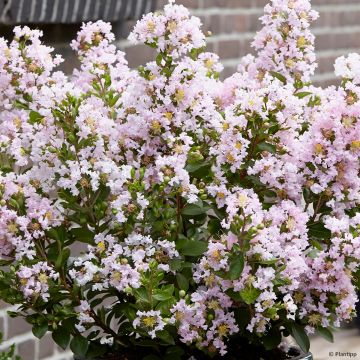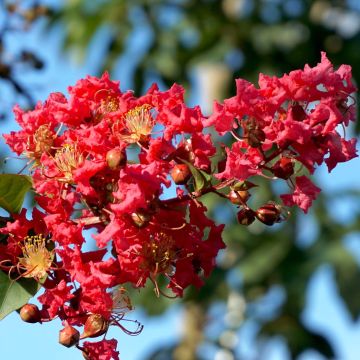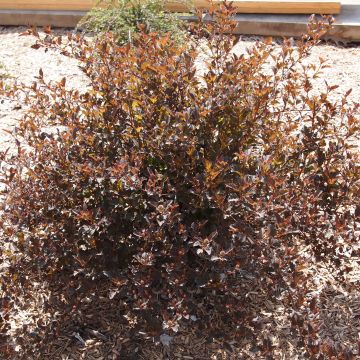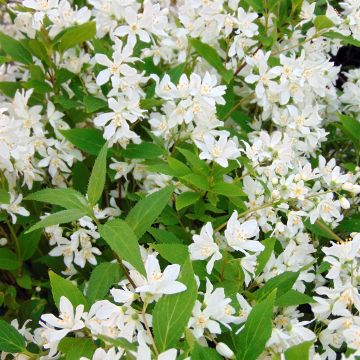

Lagerstroemia indica Red imperator - Crape Myrtle


Lagerstroemia indica Red imperator - Crape Myrtle


Lagerstroemia indica Red imperator - Crape Myrtle


Lagerstroemia indica Red imperator - Crape Myrtle
Lagerstroemia indica Red imperator - Crape Myrtle
Lagerstroemia indica Red imperator
Crape Myrtle, Crepe Myrtle, Indian Lilac
Plant received promptly after ordering, in good condition. Progress to be monitored throughout the year after planting, but I'm optimistic...
Jeannine, 25/06/2022
Special offer!
Receive a €20 voucher for any order over €90 (excluding delivery costs, credit notes, and plastic-free options)!
1- Add your favorite plants to your cart.
2- Once you have reached €90, confirm your order (you can even choose the delivery date!).
3- As soon as your order is shipped, you will receive an email containing your voucher code, valid for 3 months (90 days).
Your voucher is unique and can only be used once, for any order with a minimum value of €20, excluding delivery costs.
Can be combined with other current offers, non-divisible and non-refundable.
Why not try an alternative variety in stock?
View all →This plant carries a 24 months recovery warranty
More information
We guarantee the quality of our plants for a full growing cycle, and will replace at our expense any plant that fails to recover under normal climatic and planting conditions.
Would this plant suit my garden?
Set up your Plantfit profile →
Description
The Lagerstroemia indica 'Red Imperator' is a small Indian summer flowering Lilac with very dynamic red blooms, which bursts through the intense light of summer. This adorable deciduous bush seduces with its compact habit, making it easy to adopt in a large pot on the terrace. It also charms with its highly glossy purple foliage that colours in the autumn, and its decorative bark. Eager for sun and warmth, resistant and endowed with multiple advantages, Indian Lilacs are among the most beautiful summer-flowering bushes. They deserve a prominent place in the garden or on the terrace.
The Lagerstroemia indica 'Red Imperator' belongs to the Lythraceae family. The Lagerstroemia indica, from which it originates, is native to China. This bush has a bushy and ramified habit, with a rounded crown. It will reach an average height of 1.50 m (4 ft 11 in) at maturity, with a diameter of 1 m (3 ft 4 in). Its growth is quite fast. It chooses the end of July to start its flowering, which will continue until October. The flowers are characterised by thin pedicels, each carrying five undulating-edged petals that make up this flower. The flowers, with a crepe texture, are gathered in large, dense panicles at the ends of the branches of the year. In 'Red Imperator', the buds are crimson, then they open up into a fiery red. The leathery and deciduous foliage emerges red and then becomes dark green-purple and glossy. It comprises small ovate leaves, which sometimes take on pretty yellow or red hues in the autumn, depending on the climate. Lastly, its truly beautiful bark is smooth, beige streaked with brown-red, peeling off in coloured patches (cinnamon, faded red, old rose, cream).
This Indian Lilac is hardy and vigorous. It is when isolated, near the house, that you can fully enjoy its abundance. It will make a good impression in a shrub border, a flowering hedge, or emerging from a mound of perennials. Create a mixed border, with Campanula pyramidalis, Salvia sclarea, Aster laevis. In autumn, it is accompanied by asters as colorful as itself. In a large pot on the terrace, it puts on a show while the summer blooms fade. We have imagined a tricolour vegetal tapestry as a ground cover to showcase the Summer Lilac Red Imperator. A weaving of thyme, oregano, and candytuft will come to dress the base of its trunk, underline its bark, and reflect its sparkling flowering.
NB: Karl Von Linne named this tree to pay tribute to his friend Magnus Von Lagestroem (1696 - 1759), who had sent it to him from India for identification. Originally, this tree was used to decorate Chinese temples. We would like to point out that this tree produces fruits that have a narcotic effect if ingested.
Lagerstroemia indica Red imperator - Crape Myrtle in pictures






Plant habit
Flowering
Foliage
Botanical data
Lagerstroemia
indica
Red imperator
Lythraceae
Crape Myrtle, Crepe Myrtle, Indian Lilac
Cultivar or hybrid
Other Lagerstroemia - Crape Myrtle
View all →Planting and care
We recommend planting the Lagestroemia indica 'Red Imperator' in spring, when the risk of frost is no longer a concern, in a very sunny and sheltered location, in rich, fresh, well-drained, preferably non-calcareous, soil. It will appreciate added compost and a thick layer of dead leaves, especially during the first two winters in cold regions. It is necessary to prune the floriferous branches very short in February-March, leaving only 4 to 6 buds to balance its habit and stimulate the growth of future flower-bearing branches. If necessary, remove weak twigs and poorly positioned branches.
Planting period
Intended location
Care
Planting & care advice
-
, onOrder confirmed
Reply from on Promesse de fleurs
Similar products
Haven't found what you were looking for?
Hardiness is the lowest winter temperature a plant can endure without suffering serious damage or even dying. However, hardiness is affected by location (a sheltered area, such as a patio), protection (winter cover) and soil type (hardiness is improved by well-drained soil).

Photo Sharing Terms & Conditions
In order to encourage gardeners to interact and share their experiences, Promesse de fleurs offers various media enabling content to be uploaded onto its Site - in particular via the ‘Photo sharing’ module.
The User agrees to refrain from:
- Posting any content that is illegal, prejudicial, insulting, racist, inciteful to hatred, revisionist, contrary to public decency, that infringes on privacy or on the privacy rights of third parties, in particular the publicity rights of persons and goods, intellectual property rights, or the right to privacy.
- Submitting content on behalf of a third party;
- Impersonate the identity of a third party and/or publish any personal information about a third party;
In general, the User undertakes to refrain from any unethical behaviour.
All Content (in particular text, comments, files, images, photos, videos, creative works, etc.), which may be subject to property or intellectual property rights, image or other private rights, shall remain the property of the User, subject to the limited rights granted by the terms of the licence granted by Promesse de fleurs as stated below. Users are at liberty to publish or not to publish such Content on the Site, notably via the ‘Photo Sharing’ facility, and accept that this Content shall be made public and freely accessible, notably on the Internet.
Users further acknowledge, undertake to have ,and guarantee that they hold all necessary rights and permissions to publish such material on the Site, in particular with regard to the legislation in force pertaining to any privacy, property, intellectual property, image, or contractual rights, or rights of any other nature. By publishing such Content on the Site, Users acknowledge accepting full liability as publishers of the Content within the meaning of the law, and grant Promesse de fleurs, free of charge, an inclusive, worldwide licence for the said Content for the entire duration of its publication, including all reproduction, representation, up/downloading, displaying, performing, transmission, and storage rights.
Users also grant permission for their name to be linked to the Content and accept that this link may not always be made available.
By engaging in posting material, Users consent to their Content becoming automatically accessible on the Internet, in particular on other sites and/or blogs and/or web pages of the Promesse de fleurs site, including in particular social pages and the Promesse de fleurs catalogue.
Users may secure the removal of entrusted content free of charge by issuing a simple request via our contact form.
The flowering period indicated on our website applies to countries and regions located in USDA zone 8 (France, the United Kingdom, Ireland, the Netherlands, etc.)
It will vary according to where you live:
- In zones 9 to 10 (Italy, Spain, Greece, etc.), flowering will occur about 2 to 4 weeks earlier.
- In zones 6 to 7 (Germany, Poland, Slovenia, and lower mountainous regions), flowering will be delayed by 2 to 3 weeks.
- In zone 5 (Central Europe, Scandinavia), blooming will be delayed by 3 to 5 weeks.
In temperate climates, pruning of spring-flowering shrubs (forsythia, spireas, etc.) should be done just after flowering.
Pruning of summer-flowering shrubs (Indian Lilac, Perovskia, etc.) can be done in winter or spring.
In cold regions as well as with frost-sensitive plants, avoid pruning too early when severe frosts may still occur.
The planting period indicated on our website applies to countries and regions located in USDA zone 8 (France, United Kingdom, Ireland, Netherlands).
It will vary according to where you live:
- In Mediterranean zones (Marseille, Madrid, Milan, etc.), autumn and winter are the best planting periods.
- In continental zones (Strasbourg, Munich, Vienna, etc.), delay planting by 2 to 3 weeks in spring and bring it forward by 2 to 4 weeks in autumn.
- In mountainous regions (the Alps, Pyrenees, Carpathians, etc.), it is best to plant in late spring (May-June) or late summer (August-September).
The harvesting period indicated on our website applies to countries and regions in USDA zone 8 (France, England, Ireland, the Netherlands).
In colder areas (Scandinavia, Poland, Austria...) fruit and vegetable harvests are likely to be delayed by 3-4 weeks.
In warmer areas (Italy, Spain, Greece, etc.), harvesting will probably take place earlier, depending on weather conditions.
The sowing periods indicated on our website apply to countries and regions within USDA Zone 8 (France, UK, Ireland, Netherlands).
In colder areas (Scandinavia, Poland, Austria...), delay any outdoor sowing by 3-4 weeks, or sow under glass.
In warmer climes (Italy, Spain, Greece, etc.), bring outdoor sowing forward by a few weeks.





































































